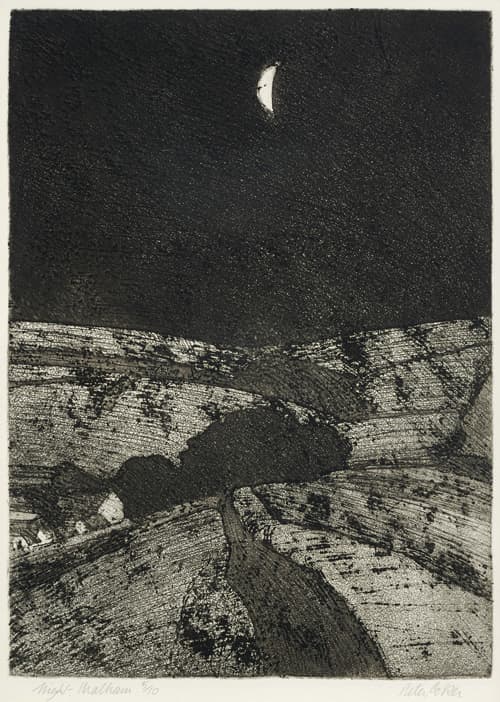
Biography
Peter Godfrey Coker was born in 1926, the son of a businessman. He was brought up in Leytonstone where he acquired a love for music from his mother and engraving from his maternal grandmother. His artistic career began at St Martin’s School of Art where he studied between 1941 and 1943, before being interrupted by three years’ in the Royal Air Force during World War II. After the war he returned to St Martin’s and studied there between 1947 and 1949. In 1949-50 he went to Italy and France where he absorbed the work of Gustave Courbet whose influence in subject matter and technique is evident in much of his work. On his return he went on to the Royal College of Art where he studied between 1950 and 1954, during which time he successfully received both a Royal and British Institution Scholarship (1951/1953). There he became acquainted with fellow artists such as Derek Greaves, John Bratby, Edward Middleditch and Jack Smith. Their artistic inclinations to paint scenes of domestic life united them as the Kitchen Sink School. He then returned to teach painting at St Martin’s (1954-73), moving to the City and Guilds of London Art (1973-85). Coker had many one-man exhibitions in London during the seventies including at the Thackery Gallery, the Mayor Gallery and Morley Gallery. Notably in 1979 he exhibited in the Royal Academy of Arts in an exhibition entitled Painting and Drawings of the Butcher’s Shop. In 1984 Coker exhibited at Gallery 10 in London. Following a series of paintings of animal carcasses, which he began in 1955 he became well known for having been inspired by butcher’s shops near his home in Leytonstone in London. He exhibited at the Zwemmer Gallery in London in 1956 (the first of four shows to be held there) and at the Royal Academy in 1979. He published a book entitled Etching Techniques in 1976.
Statement
Coker was influenced by everyday scenes, landscapes and still-lifes, painting in oils on canvas or board. His depictions, which are unsentimental and un-idealised, are created by bold forms and strong colours with thickly impasted paint. As well as oils he worked in charcoal, pencil and chalk and made a number of prints. Malham Night has attributes of all of these mediums. Although an etching, the nature of his densely harsh oils and strong charcoal sketches can be easily seen in his depiction of the small village in the Pennines. The ancient lands of the once bustling industrial village were noted in the Doomsday Book. However Coker’s representation of the now quiet farmland has incorporated the tranquillity of night alongside the mystery of the past. The area was also painted by Turner.
Bibliography
- G. MEIßNER, Saur Allgemeines Kunstler-Lexion: Band 20, K.G. Saur Verlag GumbH & Co, Munich Germany, 1998.
- BENEZIT Dictionary of Artists: Volume 3, Editions Grund, Paris France, 2006.
- WOOTTON, David and John RUSSELL TAYLOR with the contribution of Richard Humpreys, Peter Coker RA: Fully illustrated biography, catalogue raisonné of major oils, watercolours and etchings, and list of sketchbooks, 2002.
- COKER, Peter, Etching Techniques, 1976.
Cassandra Cunningham







